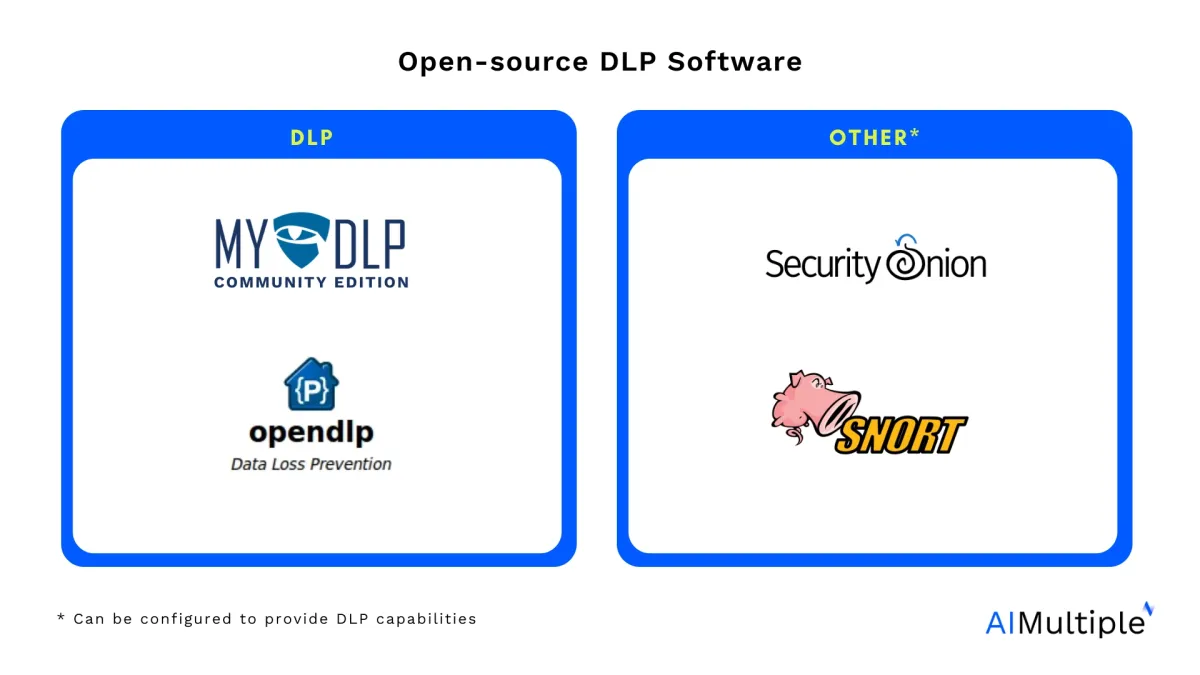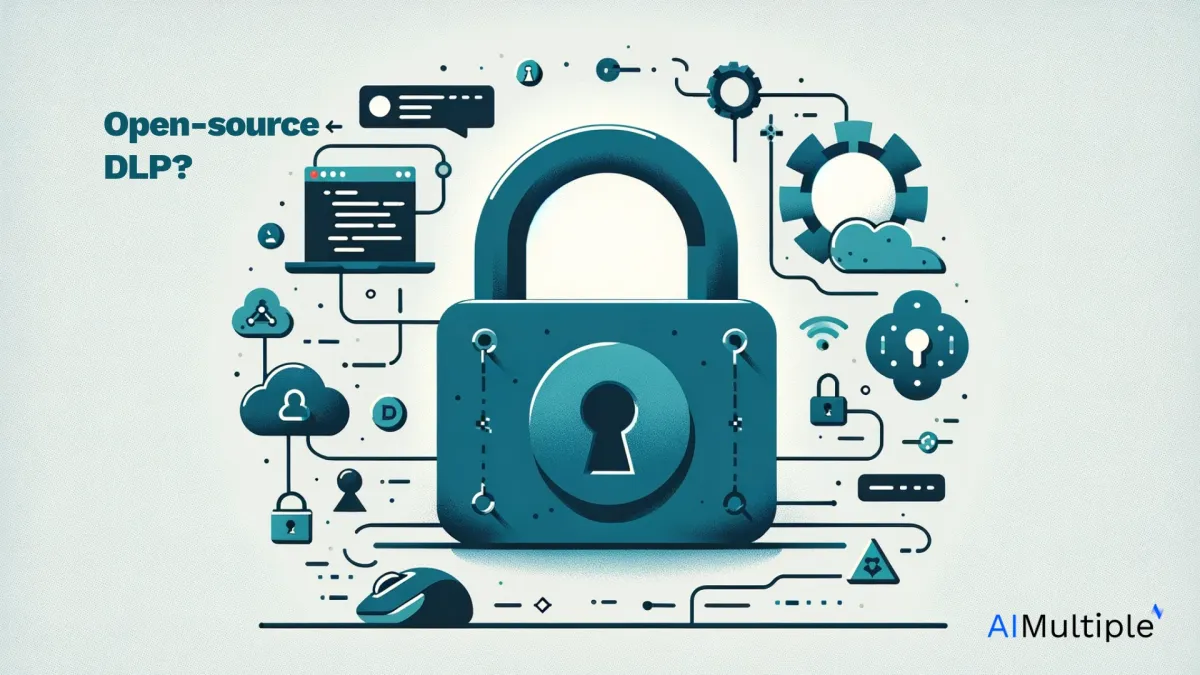Securing confidential business data is vital for organizations across all industries. While open-source DLP software presents viable solutions for data protection, larger enterprises often turn to closed-source DLP software solutions for enhanced functionality.
Here, see the top open-source DLP software, examining their features and capabilities:
Top open-source DLP software
| Software Name* | GitHub Star Rating | Supported OS | DLP/Other** | Key Features |
|---|---|---|---|---|
| MyDLP Community Edition | 82 | Windows | DLP | – Data inspection – Integration – Cloud-native |
| OpenDLP | 99 | Windows Unix | DLP | – Data discovery – Regex detection |
| Security Onion | 3.4K | Linux | Other | – Network monitoring – Intrusion detection – Log management |
| Snort | 2.7K | Linux Windows MacOS | Other | – Traffic analysis – Packet logging – Network intrusion prevention |
Inclusion criteria:
All software that offered an open-source and Free DLP solution are included.
* The tools are ranked alphabetically.
** Other: Since the open-source DLP software landscape is limited, we included some other open-source software that can be configured to perform DLP activities.
Deep dives on open-source DLP solutions

1. MyDLP Community Edition
MyDLP Community Edition is an open-source data loss prevention solution and one of the most popular on the market. It’s built to monitor and prevent sensitive data leakage.
If you require more features and enterprise-grade support, MyDLP Community Edition may fall short, and you might want to consider a closed-source DLP software.
2. OpenDLP
OpenDLP is a free and open-source, centralized data loss prevention tool that focuses on scanning data at rest.
Its main drawback is its scalability issues, which can be addressed by integrating it with a more robust, closed-source DLP system for enhanced performance and better management features.
3. Security Onion
Security Onion is a free and open-source Linux distribution for intrusion detection, network security monitoring, and log management.
It can be configured for DLP tasks by utilizing its extensive logging capabilities to monitor and alert on data exfiltration attempts. However, since it’s not specifically designed for DLP, it would primarily help in detecting potential data exfiltration attempts rather than preventing them outright.
4. Snort
Snort is an open-source network intrusion prevention system that can perform real-time traffic analysis and packet logging.
Snort can be configured to perform DLP tasks, such as detecting personally identifiable information (PII). To configure Snort for DLP tasks, custom rules can be written to detect and alert specific data patterns in network traffic that may indicate data loss or theft incidents.1
What is open-source DLP software?

Open source data loss prevention software is a type of data loss prevention solution designed to protect sensitive information from data leaks, unauthorized access, and breaches. This software provides tools for scanning sensitive data, monitoring data transfers, and preventing data loss across various platforms, including cloud services, mobile devices, and external devices.
Why are they valued?
Open-source DLP tools are particularly valued for their flexibility and adaptability, allowing IT administrators and security teams to modify source code to meet specific data security requirements and compliance standards.
They offer a cost-effective option for businesses of all sizes to safeguard customer data, financial data, and personally identifiable information, ensuring continuous protection against data exfiltration, insider threats, and data breaches.
Essential features of open-source DLP software
Data classification and governance
Detection engines are crucial to a DLP solution’s ability to identify, classify, and manage sensitive data. A good DLP solution enables the automatic classification and application of sensitivity labels to files across the entire environment. Customizable configuration of classification policies and protective measures is essential.
Access control and user activity monitoring
Role-based access control is an essential component of DLP. Tracking user identities and roles against granular policies enables a proactive approach to preventing threat actors from accessing sensitive digital assets. Granular control of access helps prevent insider threats, such as noncompliant file transfers.
Exfiltration prevention and inline scanning
Exfiltration prevention is a critical function of DLP, mitigating the potential risks of data theft and unintentional leaks. Inline scanning is required for this function, as the action must be blocked before it occurs. Preventing data theft and leaks helps reduce the number of potential attack vectors.
Future of open-source DLP software
AI and ML can enhance DLP solutions by improving detection accuracy, reducing false positives, and providing real-time threat intelligence. The evolving landscape of DLP technologies includes CASB and SASE Vendor DLP, Email and Gateway DLP, Insider Risk Management Endpoint DLP, Data Security Posture Management, and App Native DLP.
Open source vs. closed source DLP
Here, we compare open-source and closed-source software from three aspects.
1. Flexibility and customization
Open-source DLP: Open-source DLP tools, such as those used for scanning sensitive data, offer extensive customization options. These solutions enable security teams to modify the source code, tailoring the DLP tool to effectively protect sensitive information, including financial data and personally identifiable information.
This level of customization supports continuous monitoring and policy settings adjustments for businesses handling the most sensitive data.
Closed-source DLP: On the other hand, closed-source DLP software typically offers less flexibility but comes with user-friendly, pre-configured settings ideal for immediate deployment. These tools, often used by large enterprises, are designed to efficiently meet general data protection requirements, ensuring compliance with data security standards and reducing the risk of data breaches with minimal configuration.
2. Cost and accessibility
Open-source DLP: Open-source DLP solutions typically have no initial cost, making them an attractive option for small and medium-sized businesses. However, they require significant IT expertise to customize and maintain, potentially increasing the total cost of ownership, including the need for ongoing management and updates to safeguard against data theft and leaks.
Closed-source DLP: Conversely, closed-source DLP solutions involve upfront and ongoing licensing fees, but they also include vendor support for incident management, updates, and troubleshooting. This can provide a more predictable expense and less administrative overhead for IT administrators, especially in environments with extensive data transfers or where sensitive data is stored across cloud services and external devices.
3. Security and support
Open-source DLP: The security of open-source DLP software relies heavily on the community and the active involvement of its users. While flexible, this approach requires a proactive stance on security updates and may not provide the same level of immediate support as closed-source alternatives.
It’s well-suited for organizations with capable technical teams dedicated to protecting data at rest and in transit, managing data access, and preventing data loss through continuous adjustments and monitoring.
Closed-source DLP: Closed-source DLP solutions often offer more comprehensive security features out of the box, designed for robust protection against insider threats, unauthorized file transfers, and data exfiltration.
With dedicated support from the vendor, these solutions help streamline compliance requirements and provide a centralized dashboard for monitoring suspicious behavior and managing data breach incidents effectively.
| Aspect | Open Source | Closed Source |
|---|---|---|
| Flexibility | Customizable for specific needs but requires expertise. | Pre-configured, user-friendly, and ideal for quick deployment. |
| Cost | Free but requires resources for management and updates. | Paid with vendor support for maintenance and upgrades. |
| Security | Relies on community-driven updates and proactive security measures. | Built-in advanced protection and streamlined compliance with vendor backing. |
Open-source DLP tools offer affordability and flexibility for smaller businesses and organizations that have the necessary technical expertise. However, their limitations in scalability and support often make closed-source solutions the preferred choice for enterprises requiring strong protection.
Other open-source software for data protection
1. Wazuh
- Purpose: Primarily a Security Information and Event Management (SIEM) solution, Wazuh offers capabilities to monitor file integrity, detect vulnerabilities, and manage data leaks through its extensive logging and alerting capabilities.
- Features: Endpoint monitoring, log analysis, and intrusion detection can be configured for DLP-like functionality.
- GitHub Stars: ~4.9 K.
2. ModSecurity
- Purpose: Open-source web application firewall that can be configured for DLP purposes by writing custom rules to detect and block specific sensitive data patterns in HTTP traffic.
- Features: Real-time traffic analysis and custom rule support.
- GitHub Stars: ~6.8 K.
3. OSSEC
- Purpose: Another open-source security tool that functions as a host-based intrusion detection system (HIDS) and can monitor changes in files or detect sensitive data leaks when configured with custom rules.
- Features: File integrity monitoring and alerting.
- GitHub Stars: ~4.3 K.
4. Pi-hole
- Purpose: Although primarily a DNS-level ad and tracker blocker, it can be adapted to filter or block domains involved in data exfiltration.
- Features: DNS-based monitoring and filtering.
- GitHub Stars: ~43 K.
5. ELK Stack (Elasticsearch, Logstash, Kibana)
- Purpose: While it’s a logging and data visualization tool, it can be tailored for DLP tasks through custom dashboards, queries, and anomaly detection in data flows.
- Features: Log ingestion, analysis, and customizable alerting.
- GitHub Stars: Elasticsearch ~64K, Logstash ~13K, Kibana ~18 K.
These tools can be configured or extended to perform specific DLP-related tasks; however, they may require significant customization and expertise to achieve the same level of effectiveness as purpose-built DLP software.
FAQs for open-source DLP software
-
What is DLP?
Data Loss Prevention (DLP) is a suite of technologies and solutions designed to prevent the unauthorized transfer, access, and exfiltration of sensitive data within an organization. DLP software scans and monitors data at rest, in use, and in motion to detect and prevent data breaches, data leaks, and data theft.
These solutions are crucial for protecting sensitive information, such as customer data, financial data, medical record numbers, and intellectual property.
DLP tools are used across various platforms, from cloud services and mobile devices to USB and removable storage devices, ensuring comprehensive data protection and compliance with data security standards like PCI DSS. They employ real-time monitoring, incident management, and policy settings to safeguard the most sensitive data against insider threats and external devices.Open-source DLP solutions provide a cost-effective alternative for businesses of all sizes, from small businesses to large enterprises, allowing for continuous monitoring and adaptation to new threats. They are user-friendly and support integration with systems like Microsoft Exchange and Microsoft Azure, enhancing security teams’ ability to prevent data loss and manage policy violations through a centralized dashboard.
-
What are the types of DLP?
Data Loss Prevention (DLP) solutions are categorized into three primary types:
1. Network DLP: Monitors and protects data in transit across the network to prevent data breaches and unauthorized data transfers.
2. Endpoint DLP: Focuses on securing sensitive data on endpoint devices like laptops, mobile devices, and USB devices, employing real-time monitoring and policy enforcement to prevent data leakage and theft.
3. Cloud DLP: Protects sensitive information stored in cloud services and managed through cloud-native tools, ensuring data security across all cloud-based file transfers and storage solutions.
Further reading
- Tackling Critical Data Protection Challenges
- Top 10 LLM DLP Best Practices
- Top 7 AI DLP Best Practices with Case Studies


Comments
Your email address will not be published. All fields are required.